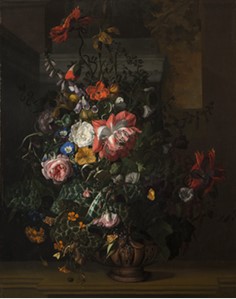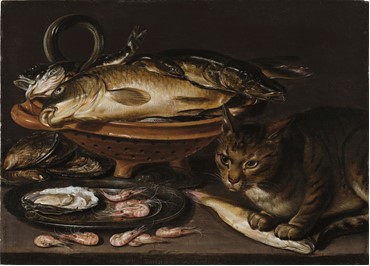Reviving History: Celebrating Female Artists of the Dutch Golden Age
Jenna Mangis
Wall Panel
At the start of the Twelve Years’ Truce with Spain in 1609, The Netherlands saw an unprecedented period of political, economic, and cultural richness, referred to as “The Dutch Golden Age” (Rowen). The economic shift from production to trade bolstered the economy, led to a growing middle class, and, as a result, an increase in the demand for goods such as paintings (Coutré 27). Additionally, at this time, oil painting became the dominant medium in Europe because of its versatility (Jones). The National Museum of Women in the Arts’ Exhibition Women Artists of the Dutch Golden Age features the masterful still life and genre scene oil paintings of Judith Leyster, Rachel Ruysch, and Clara Peeters along with the intricate engravings of Maria Sibylla Merian and Anna Maria van Schurman. While not nearly as celebrated or remembered as their male counterparts, these female artists used their new and unique positions in the growing wealthy middle class to display their artistic skills and talents.
Being female artists, these women were limited in what they were able to paint (Kukota). Through their depictions of everyday objects and life, more is revealed about cultural priorities in the arts and sciences. These women used their art to cement their place in society and as artists while constrained by the gender bias of the time. This impressive lineup shows that even when restricted by society, these female artists were able to flourish and need to be remembered and celebrated.
Object Label 1

Rachel Ruysch. Roses, Convolvulus, Poppies and Other Flowers in an Urn on a Stone Ledge. Late 1680s. Oil on canvas.
Daughter of a prominent scientist and professor, Ruysch grew up in a wealthy family enabling her to cultivate her artistic talent (Robinson). Marriage and motherhood were typically a death sentence for female artists’ careers (Robinson). Defying this norm, Ruysch was incredibly successful after her marriage (Robinson). In this work, Ruysch skillfully utilizes lights and darks to create contrast between the flowers and the suggestion of a room behind. The combination of lively flowers placed in an urn may suggest Ruysch’s struggle between balancing her successful career and duty as mother. A contrast similar to this merging of life and death.
Object Label 2

Anna Maria van Schurman. Self-portrait. 1640. Engraving on paper.
Along with being a skilled artist, Van Schurman was a linguist, poet, philosopher, and intellectual (“Van Schurman”). Being the first women in Europe to attend University, Van Schurman held a unique position in society (“Van Schurman”). Depicting herself in an expensive gown, Van Shurman’s complex mix of etching and engraving, shows off her impressive resume. The Latin reads: “See my likeness depicted in this portrait/May your favor perfect the work where art has failed” (“Self-Portrait”). Enabled by her wealth and intellect, Van Schurman could use art as a way to cement her elevated status in society.
Object Label 3

Peeter, Clara. Still Life of Fish and Cat. After 1620, National Museum of Women in the Arts, https://nmwa.org/art/collection/still-life-fish-and-cat/.
Known as a pioneer in banquet and breakfast still life painting, Clara Peeters skills are clearly on display in this work (Yalzadeh). Most likely trained by a master painter, Peeters’ work reflects an incredible amount of time and focus (Yalzadeh). Being in the middle class, she would have had the time to devote to painting (Yalzadeh). The cat, focused and perching, almost blends into the surrounding scene. Does this contrast of the lively cat and the dead fish represent the thin line of what is valued by society, or was it simply a way for her to show off her incredible skill?
Object Label 4

Judith Leyster. The Concert. 1633. Oil on canvas.
Though famously known for her painting Self Portrait, Judith Leyster also excelled at genre scenes (Kukota 149). Her skillful use of contrast, not only in color but in texture and brushstrokes, work together to create impressive scenes (Kukota 149). Leyster trained numerous painters and was well regarded in her community (Kukota 152). Painted in an elegant gown, framed by musicians, she seems to depict her own wealthy and respected status. Her expression depicts a joyful mood, perhaps surrounded by people that bring her that joy. Perhaps a husband? A neighbor? A son? Sadly, after her death, she was mostly forgotten – a legacy lost to time (Kukota 152).
Object Label 5

Maria Sibylla Merian. Plate 18 (from “Dissertation in Insect Generations and Metamorphosis in Surinam,” second edition). 1719. Hand-colored engraving on paper.
Not confined to her role as only an artist and mother, Maria Sibylla Merian was also a successful botanist and scientist (Klein). One of her most notable accomplishments being disproving the popular belief that insects emerged from mud (Klein). This engraving depicts spiders climbing on an intricate web on a lemon tree. Though these plates are of her scientific observations, the inclusions of smaller spiders may reflect Merian’s own interest in motherhood and family. Using her artistic talent and unique status in life, Merian was able to thrive in the arts and sciences.
Works Cited
Coutré, Jacquelyn. “The Advent of Amsterdam: Painting and Prosperity in the Dutch Golden Age.” Queen’s Quarterly, vol. 123, no. 1, Spring, 2016, pp. 26-47. ProQuest, http://proxyau.wrlc.org/login?url=https://www-proquest-com.proxyau.wrlc.org/magazines/advent-amsterdam-painting-prosperity-dutch-golden/docview/1791897265/se-2?accountid=8285.
Jones, Susan. “Painting in Oil in the Low Countries and Its Spread to Southern Europe.” metmuseum.org, October 2002, https://www.metmuseum.org/toah/hd/optg/hd_optg.htm
Klein, Joanna. “A Pioneering Woman of Science Re‑Emerges After 300 Years.” New York Times, 23 January 2017, https://www.nytimes.com/2017/01/23/science/maria-sibylla-merian-metamorphosis-insectorum-surinamensium.html.
Kukota, Irene. “Judith Leyster: The Artist Vanishes.” Thanks for Typing: Remembering Forgotten Women in History. Edited by Juliana Dresvina, e-book, Bloomsbury, 2021, pp. 143-162.
Leyster, Judith. The Concert. 1633, National Museum of Women in the Arts, https://nmwa.org/art/collection/concert/.
Merian, Maria Sibylla. Plate 18 (from “Dissertation in Insect Generations and Metamorphosis in Surinam”, second edition), 1719, National Museum of Women in the Arts, https://nmwa.org/art/collection/plate-18-dissertation-insect-generations-and-metamorphosis-surinam/.
Peeter, Clara. Still Life of Fish and Cat. After 1620, National Museum of Women in the Arts, https://nmwa.org/art/collection/still-life-fish-and-cat/
Robinson, Lynn. “Ruysch, Flower Still-Life.” Khan Academy, n.d., https://www.khanacademy.org/humanities/renaissance-reformation/baroque-art1/holland/a/ruysch-flower-still-life
Rowen, Herbert H. “Dutch civilization in the Golden Age (1609–1713).” Encyclopedia Britannica, 29 Jan. 2021, https://www.britannica.com/place/Netherlands/Dutch-civiliz ation-in-the-Golden-Age-1609-1713.
Ruysch, Rachel. Roses, Convolvulus, Poppies and Other Flowers in an Urn on a Stone Ledge, Late 1680s, National Museum of Women in the Arts, https://nmwa.org/art/collection/roses-convolvulus-poppies-and-other-flowers-urn-stone-ledge/.
“Self-Portrait.” National Museum of Women in the Arts, n.d., https://nmwa.org/art/collection/schurman-self-portrait/. Accessed 16 February 2021.
“Van Schurman (1607-1678).” Project Vox, n.d., https://projectvox.org/van-schurman-1607-1678/. Accessed 16 February 2021.
Van Schurman, Anna Maria. Self-portrait. 1640, National Museum of Women in the Arts, https://nmwa.org/art/collection/schurman-self-portrait/.
Yalzadeh, Ida. “Clara Peeters”. Encyclopedia Britannica, 30 Jan. 2020, https://www.britannica.com/biography/Clara-Peeters.
